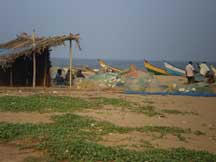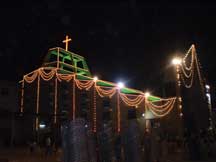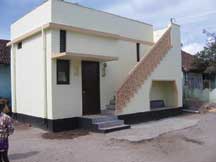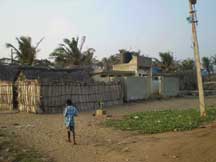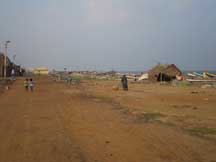India
The Tsunami: Three Years Later

Little India revisits the villages hit by the Tsunami in South India.
|
It’s been more than three years since the water receded…and came back with destructive force. Southeastern India was just one of 11 countries inundated by the 2004 tsunami that destroyed lives, villages, and sparked a recovery crisis for the international community. Three years ago, I was a reporter sent to India to document the days of recovery in the aftermath of the tsunami. As a second-generation Indian American with strong connections with Tamil Nadu (more than half of my extended family still lives there), I was in a unique position to see the impact of the destruction as both a journalist and an NRI. While as the former, I was able to negotiate the information-gathering process through my fluency in Tamil, the latter me was shaken to the core.
Many of us in the United States have likely forgotten how the overseas Indian community rallied to help those affected by the tsunami in India and Sri Lanka. We sent millions in aid to non-profit NGOs and other organizations to aid the relief. Nine months later, in the wake of another international crisis sparked by Hurricane Katrina, many of us who had complained about the Indian government’s response to natural disasters could only watch in shock and anger as the U.S. government did virtually nothing in the days after the worst natural catastrophe to hit the United States in modern history. With Katrina on our minds and the wars in Iraq and Afghanistan returning to their dominance in the public sphere, the tsunami relief effort receded from the minds of even those who had passionately donated for tsunami relief. What happened to the people whose lives were destroyed in a matter of minutes? What happened to the promises by the Indian central and Tamil Nadu state governments about on development programs in the areas most affected? With those questions in mind, I returned to India in December. I was cautiously eager to see what had become of the Tamil Nadu coast, where generations of Tamilians have lived off the sea. As the son of Indian immigrants who have as much faith in the Indian government as most Americans have in George W. Bush, I knew my enthusiasm for India’s post-tsunami recovery had to be tempered by the reality on the ground: mismanaged money, political fighting, and most importantly, indifference once the international spotlight went away. One of the first places I visited was Puducherry (more widely known as Pondicherry), my mother’s birthplace and one of the areas hit hardest by the tsunami. Though Puducherry has had a thriving tourism industry driven by its French past and by the millions who come annually to the Sri Aurobindo ashram, the “real” Puducherry rested on a strong fishing economy. In the wake of the tsunami, many fishermen and women found themselves without boats, nets, and most of all, homes in the low-lying areas along the coast. What’s worse is that many in the territory feared the sea, the very waters that had given Puducherry its reputation as one of India’s wonders. Because of Puducherry’s relatively small size and its unique position as a union territory (not exactly a state, but not a city, either), the Puducherry government was able to effectively handle its recovery, especially with the help of its foreign visitors.
Puducherry has returned to its former vibrancy, and the fishing boats are again out on the Bay of Bengal, restoring many Puducherrians to their former livelihood. Tourists are back, and with them the dollars for the economic recovery. But other parts of the southeastern coast are not so fortunate. Along the ECR Highway in Tamil Nadu, I saw remnants of villages that were leveled by the tsunami. More importantly, I noticed that the Indian and Tamil Nadu governments had “outsourced” the role of recovery to churches, which have had a growing influence in the South over the past two decades. As I passed small villages that had been moved to the other side of ECR road, giant new churches – a number of them belong to foreign Evangelical congregations – stood as testaments to an international and controversial Christian response to the tsunami. While secular NGOs and individual donors from the Indian diasporic community have poured in money, time and resources, churches – by their sheer will and persistence – have had stronger ground access. When I covered the tsunami recovery efforts, there were reports of fishermen preventing Christian aid groups from entering their villages because of the likelihood that missionaries would try to proselytize Hindus. Though they have faced resistance, especially from devout Hindu villagers, these churches along the coast are representative of a new, post-tsunami Tamil Nadu. However, the appearance of churches, including a Midwestern U.S.-style “megachurch” south of Chennai, and the government’s attempts at “moving” villages to areas less susceptible to tsunami damage was not as indicative as quality of life issues. On my way back from Mahabalipuram, I stopped by a small village that had been severely damaged by the flooding caused by the tsunami. Tamil officials had told me then to write in assuring terms that international aid would be sent to the village along with others nearby.
What struck me was that the quality of life had not significantly improved since the days after the tsunami. There was a new church and some land that had been recently purchased by an Adventist congregation, but the actual village itself showed no signs of the kind of economic development the Indian expatriate community had been promised. Maybe as an American, I’d been conditioned to think that progress meant new buildings and new technology, the kinds of things that added to a community’s infrastructure and its aesthetics. Yet the villagers were still washing clothes in the same muddy waters as their children bathed in. I asked my uncle Jayaraman, whose Rotary Club had helped several villages extensively in the weeks and months after the tsunami, whether recovery had actually occurred in some of these villages. “When their life returns to normal, that’s all you can ask for,” he said. “You cannot base these things on just what you see.” At the Elliots Beach extension in Chennai, which had been ravaged by the giant wave, dozens of people perished and an entire fishing village was swept away. Three years later, a sense of normalcy has returned to the beach, thanks to government-led cleanup efforts. A group of teenage boys from the fishing village played a variation of cricket on the same beach that had been filled with debris and bodies in 2004. Nearby were some newly constructed huts. We marveled at how villagers had returned to their daily rituals, as if nothing had happened to them. We wondered aloud if this could ever take place in New Orleans, where thousands of people are still living in FEMA trailers or continue to rely on the federal government for help.
Beyond the villagers who have made their living off the sea, the tourists and pilgrims have also returned to Chennai’s beaches. On New Year’s Eve, thousands of partygoers occupied the beaches, while even more thousands packed the Annai Velankanni Church and the Ashtalakshmi Temple nearby. Only three years earlier, both religious landmarks were safe havens for those trying to escape the wave and in the days after, were places of mourning. My family’s driver, Vijay, a Catholic, remembered how funeral services were conducted daily in the days and weeks following the tsunami. He said that since then, the church used the tsunami as a rallying cry for the community among Christians. Now, he says, many members of the Velankanni congregation are more fervent in their faith. Similarly, the Ashtalakshmi Temple is usually filled to capacity for evening dharshans. Worshippers can walk to the top of the temple and see the waves crash against the beach only yards away, reminding them that the sea is ever-strong and ever-looming. With Chennai’s beaches rehabilitated and its fishing and tourist economies recovering, the collective memory about the tsunami is fading. As an American, I remember almost everything about the Sept. 11, 2001, attacks on the World Trade Center and the Pentagon. However, it’s unlikely that many Indians have given any recent thoughts to the tsunami and how it changed southeastern India forever in just a matter of minutes. Perhaps the urban reconstruction following the tsunami and Tamil Nadu’s obsession with building new housing for the upper middle class has lessened the psychological impact of the disaster. But even as the southeastern coast has reached various stages of redevelopment, identities and ways of living are changing – and most Tamilians are oblivious of those changes. Just as urbanization and industrialization changed the rural landscape in southern India, so has the tsunami changed the way that coastal cultures and economies function. Redevelopment has focused on shifting the ways of living to Tamil Nadu’s rapidly increasing demand for service sector employment.
In Chennai, American chains and Western-inspired restaurants have opened up along the beach areas, displacing local vendors. Training now for local youth focuses on English fluency, the kind that allows service sector employees to interact conversationally with foreign visitors. Moreover, the programs established for tsunami recovery have made the coastal Tamilians more immersed in India’s transformation from a rural, manual labor economy to an industrialized, technical one. For example, in Nagapattinam, the area most heavily impacted by the tsunami, foreign companies are implementing training programs for technical vocations, such as automotive repair and for aspiring entrepreneurs to start and maintain their own businesses. My uncle Raghuraman, a consultant on one of the many foreign recovery projects in Nagapattinam, says that in addition to the shift in education, new housing caters to the lifestyle changes along the coast. “The recovery is quite good,” he says. While he acknowledges that some shifts in the local economy will take place, “the fishing economy will still be quite high. There will be some change, but it will be for good.”
What does all this mean for the southeastern Indian coast and for those of us invested in the region’s recover? It is hard to quantify yet. The tsunami recovery efforts fall in that gray zone, with qualifiers. Will Tamilians and the rest of India remember the tsunami’s significance decades from now? Or will the great wave disappear altogether from public consciousness, replaced by luxury condos, English-speaking Tamilians working at Subway, and other markers of India’s full immersion into global capitalism? |

